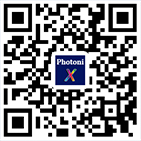| [1] |
Forbes A, de Oliveira M, Dennis MR. Structured light. Nat Photon. 2021;15:253–62.
|
| [2] |
Zhang Y, Wang Y, Wang M, Guo Y, Li X, Chen Y, et al. Multi-focus light-field microscopy for high-speed large-volume imaging. PhotoniX. 2022;3:30.
|
| [3] |
Qiao Z, Wan Z, Xie G, Wang J, Qian L, Fan D. Multi-vortex laser enabling spatial and temporal encoding. PhotoniX. 2020;1:1–14.
|
| [4] |
Goodman JW. Speckle Phenomena in Optics: Theory and Applications. Englewood: Roberts and Company Publishers; 2007.
|
| [5] |
Andrews L, Phillips R. Laser Beam Propagation Through Random Media. 2nd ed. Bellingham: SPIE; 2005.
|
| [6] |
Goodman JW. Statistical Optics. New York: Wiley; 2015.
|
| [7] |
Yu J, Zhu X, Wang F, Chen Y, Cai Y. Research progress on manipulating spatial coherence structure of light beam and its applications. Prog Quant Electron. 2023;91–92:100486.
|
| [8] |
Redding B, Choma MA, Cao H. Speckle-free laser imaging using random laser illumination. Nat Photon. 2012;6:355–9.
|
| [9] |
Peng Y, Choi S, Kim J, Wetzstein G. Speckle-free holography with partially coherent light sources and camera-in-the-loop calibration. Sci Adv. 2021;7:eabg5040.
|
| [10] |
Batarseh M, Sukhov S, Shen Z, Gemar H, Rezvani R, Dogariu A. Passive sensing around the corner using spatial coherence. Nat Commun. 2018;9:3629.
|
| [11] |
Lu X, Shao Y, Zhao C, Konijnenberg S, Zhu X, Tang Y, et al. Noniterative spatially partially coherent diffractive imaging using pinhole array mask. Adv Photon. 2019;1:016005.
|
| [12] |
Peng D, Huang Z, Liu Y, Chen Y, Wang F, Ponomarenko SA, Cai Y. Optical coherence encryption with structured random light. PhotoniX. 2021;2:1–15.
|
| [13] |
Liu Y, Dong Z, Zhu Y, Wang H, Wang F, Chen Y, Cai Y. Three-channel robust optical encryption via engineering coherence Stokes vector of partially coherent light. PhotoniX. 2024;5:8.
|
| [14] |
Yu J, Xu Y, Lin S, Zhu X, Gbur G, Cai Y. Longitudinal optical trapping and manipulating Rayleigh particles by spatial nonuniform coherence engineering. Phys Rev A. 2022;106:033511.
|
| [15] |
Zhao X, Wang Z, Lu X, Zhang H, Zhu J, Gao J, et al. Ultrahigh precision angular velocity measurement using frequency shift of partially coherent beams. Laser Photonics Rev. 2023;17:2300318.
|
| [16] |
Wolf E. Introduction to the Theory of Coherence and Polarization of Light. Cambridge: Cambridge University; 2007.
|
| [17] |
Wolf E. New theory of partial coherence in the space-frequency domain. Part I: Spectra and cross spectra of steady-state sources. J Opt Soc Am. 1982;72:343–51.
|
| [18] |
Liu L, Liu W, Wang F, Cheng H, Choi DY, Tian J, Cai Y, Chen S. Spatial coherence manipulation on the disorder-engineered statistical photonic platform. Nano Lett. 2022;22:6342–9.
|
| [19] |
Wooten EL, Kissa KM. A review of lithium niobate modulators for fber-optic communications systems. IEEE J Sel Top Quantum Electron. 2000;6:69.
|
| [20] |
Wang Y, Zhou S, He D, Hu Y, Chen H, Liang W, et al. Electro-optic beam deflection based on a lithium niobate waveguide with microstructured serrated electrodes. Opt Lett. 2016;41:4739.
|
| [21] |
Wang C, Zhang M, Chen X, Bertrand M, Shams-Ansari A, Chandrasekhar S, Loncar M. Integrated lithium niobate electro-optic modulators operating at CMOS-compatible voltages. Nature. 2018;562:101.
|
| [22] |
He M, Xu M, Ren Y, Jian J, Ruan Z, Xu Y, Liu L. High-performance hybrid silicon and lithium niobate Mach-Zehnder modulators for 100 Gbit s-1 and beyond. Nat Photonics. 2019;13:359.
|
| [23] |
Xu M, He M, Zhang H, Jian J, Cai X. High-performance coherent optical modulators based on thin-film lithium niobate platform. Nat Commun. 2020;11:3911.
|
| [24] |
Wolf E. Unified theory of coherence and polarization of random electromagnetic beams. Phys Lett A. 2003;312:263–7.
|
| [25] |
Wolf E, Collett E. Partially coherent sources which produce the same far-field intensity distribution as a laser. Opt Commun. 1978;25:293–6.
|
| [26] |
Wang F, Lv H, Chen Y, Cai Y, Korotkova O. Three modal decompositions of Gaussian Schell-model sources: comparative analysis. Opt Express. 2021;29:29676–89.
|
| [27] |
Gbur G, Visser TD. Young’s interference experiment: Past, present, and future. Prog Opt. 2022;67:275–343.
|









 下载:
下载:



